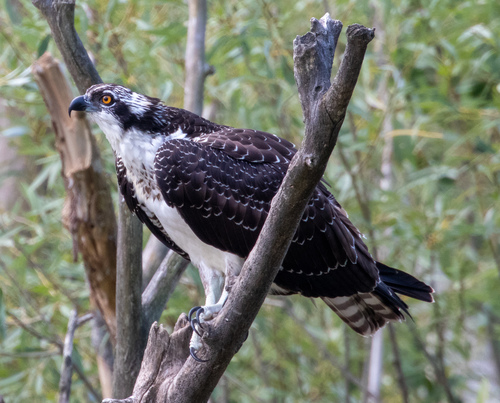
Osprey
The Osprey (Pandion haliaetus), also known as the fish hawk, is a unique and widely distributed bird of prey. It is renowned for its exceptional fishing abilities and is often found near bodies of water across the globe. Unlike most raptors, the Osprey feeds almost exclusively on live fish, showcasing remarkable adaptations for this specialized diet. Ecologically, Ospreys serve as an indicator species, reflecting the health of aquatic ecosystems. Their recovery from near extinction in some regions during the 20th century, due to pesticide use, is a significant conservation success story.
52-60 cm
Length
150-180 cm
Wingspan
Least Concern
Conservation Status
Distribution
Ospreys have a near-global distribution, found on every continent except Antarctica. They breed in North America, Europe, Asia, and Australia, and many populations migrate long distances to wintering grounds in South America, Africa, and Southeast Asia. Their altitudinal range extends from sea level to over 4,000 meters.
Lifespan
The average lifespan in the wild is 7-10 years, but some individuals can live much longer, with records of over 25 years.
Osprey's Habitat
Habitat Types
Coastal areas, Lakes, Rivers, Reservoirs, Estuaries, Mangrove swamps
Climate Zones
Tropical, Subtropical, Temperate, Boreal
Adaptations
Ospreys have several key adaptations for their aquatic lifestyle. These include reversible outer toes and spiny scales (spicules) on their feet, which help them grip slippery fish. They also possess dense, oily plumage for water repellency and closeable nostrils to prevent water entry during dives.
Variations
Several subspecies are recognized, differing slightly in size and plumage. For example, *Pandion haliaetus carolinensis* (North America) is generally larger than *Pandion haliaetus haliaetus* (Eurasia).
Appearance
Breeding Plumage
Plumage is generally similar year-round.
Seasonal Feather Changes
Minor variations may occur, with fresh plumage after molting appearing slightly brighter.
Sex Based Plumage Differences
Adult males and females have similar plumage: dark brown upperparts and white underparts, with a white head featuring a dark eye stripe. Females often have a more pronounced 'necklace' of brown streaks across the chest.
Notable Features
Reversible outer toe, Spiny scales (spicules) on feet, Closeable nostrils, Dark eye stripe
Diet and Feeding
Primary Foods
Live fish
Foraging Behavior
Ospreys hunt by soaring over water, often hovering before plunging feet-first to capture fish near the surface. They may also perch on elevated locations to scan for prey. Their dives can be spectacular, sometimes submerging completely.
Specializations
Their reversible outer toe allows them to grasp fish with two toes in front and two behind, providing a secure grip. The spicules on their feet further enhance this grip.
Seasonal Diet Variations
Diet primarily consists of fish year-round, though the specific species consumed may vary depending on availability and location. During migration or in areas with limited fish, they may occasionally take other prey like small mammals, birds, or reptiles, but this is rare.
Behavior
Social Structure
Ospreys are generally solitary or found in pairs during the breeding season. Outside of breeding, they may congregate in loose groups, especially at abundant food sources or during migration.
Communication
Vocalizations, including a series of sharp whistles or chirps, Aerial displays, used in courtship and territorial defense, Body postures, such as raising the crest or wings
Migration
Many Osprey populations are migratory, undertaking long-distance journeys between breeding and wintering grounds. Some populations, particularly in tropical areas, are resident year-round.
Territorial or Group Behaviors
Breeding pairs are strongly territorial, defending the area around their nest from other Ospreys and potential predators. They may nest in loose colonies where suitable nest sites are clustered.
Conservation
Threats
Historical pesticide use (especially DDT), Habitat loss and degradation, Human disturbance at nest sites, Collisions with power lines and other structures, Entanglement in fishing gear
Protection Programs
Bans on organochlorine pesticides (like DDT), Habitat restoration and protection, Provision of artificial nesting platforms, Monitoring of populations, Public education and outreach
Local National Laws
Ospreys are protected under various national and international laws, including the Migratory Bird Treaty Act in the United States and the Birds Directive in the European Union.
Population Trend
Increasing
Population Estimates
The global population is estimated to be around 460,000 individuals, and it is generally increasing following recovery from past declines.
Interesting Facts
Ospreys can carry fish weighing up to half their own body weight.
This impressive feat is aided by their strong talons and specialized feet.
They often orient the fish head-first while carrying it in flight.
This reduces air resistance, making it easier to transport the prey.
Osprey nests can become enormous over time.
Pairs often reuse the same nest year after year, adding new material each season.
Ospreys have been observed to shake their body mid-flight after diving.
This is to shed excess water from their feathers.
Faqs about Osprey
What is the main threat to Ospreys today?
While populations have recovered significantly, ongoing threats include habitat loss, human disturbance, and collisions with structures.
Do Ospreys mate for life?
Ospreys are generally monogamous and often form long-term pair bonds, returning to the same nest site each year. However, 'divorce' can occur, and pairs may change if one partner dies.
How can I tell an Osprey from an eagle?
Ospreys have a distinctive white head with a dark eye stripe, a more slender body than most eagles, and a characteristic 'M' shape to their wings in flight. They also have a unique, almost gull-like call.
Are ospreys endangered?
Ospreys are currently classified as 'Least Concern' by the IUCN. While they faced severe population declines in the mid-20th century due to pesticide use, they have made a remarkable recovery in many regions.
Copyright @ Nature Style Limited. All Rights Reserved.
 English
English